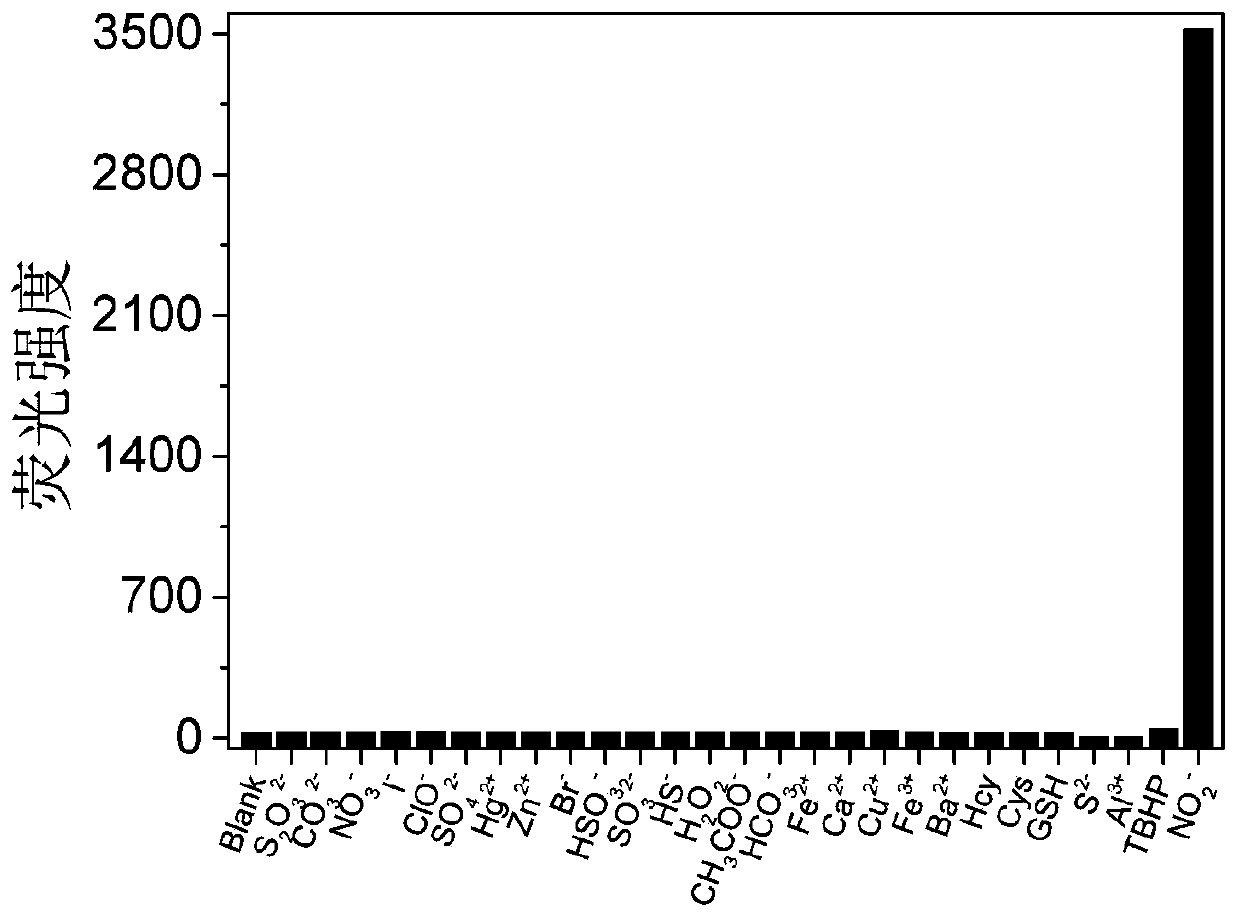Fluorescence probe used for detecting nitrite content and production method and application thereof
A fluorescent probe and nitrite technology, which is applied in the field of fluorescent probes for detecting nitrite content and its preparation and application, can solve the problems of long time consumption, poor selectivity, low sensitivity, etc., and achieve short response time , good selectivity, and highly recognizable effects
- Summary
- Abstract
- Description
- Claims
- Application Information
AI Technical Summary
Problems solved by technology
Method used
Image
Examples
Embodiment 1
[0024] The structure of a fluorescent probe for detecting nitrite is as follows:
[0025]
[0026] (1) Under nitrogen atmosphere, dissolve 9-bromoanthracene acid anhydride in the organic solvent absolute ethanol and place it in a 100mL double-necked round bottom flask, then add 1 times the molar amount of 3-amino-1-propanol to the reaction The mixture was refluxed at 70° C. for 4 hours. After the reaction was cooled to room temperature, the solvent was removed, and compound 1 was obtained as a yellow solid by silica gel column chromatography.
[0027] (2) Add compound 1 and 4 times the molar amount of o-phenylenediamine to the organic solvent absolute ethanol and place it in a 100mL double-necked round bottom flask. Under nitrogen atmosphere, add 2 times the equivalent of triethylamine to the reaction mixture , refluxed at 75° C. for 5 hours, cooled to room temperature after the reaction was stopped, and removed the solvent. Finally, the obtained crude product was purified ...
Embodiment 2
[0030] See figure 2 . Selectivity of Fluorescent Probes for Nitrite.
[0031] The fluorescent probe in Example 1 was used to evaluate the selectivity of the probe to nitrite. figure 2 is the fluorescent probe (concentration is 1.0×10- 5 mol / liter) in phosphate buffer solution (pH=1), when various common interfering species are added, the change of the fluorescence intensity of the solution, such as the 50-fold molar amount of S 2 o 3 2- ,NO 3 - ,I - ,ClO - , SO 4 2- ,Hg 2+ ,Zn 2+ ,Br - , HSO 3 - ,HS - ,H 2 o 2 ,CH 3 COO - , HCO 3 - , Fe 2+ , Ca 2+ ,Cu 2+ , Fe 3+ ,Hcy,Cys,GSH,Al 3+ , TBHP. The excitation wavelength of the fluorescent probe is 440 nm, and the emission wavelength is 522 nm. When nitrite is added to the fluorescent probe solution in a molar amount 8 times that of the fluorescent probe, the fluorescence intensity of the fluorescent probe solution is enhanced nearly 140 times. When various common interfering species were added, the fluo...
Embodiment 3
[0033] See image 3 . Linear relationship between absorbance of fluorescent probe and nitrite concentration.
[0034] The fluorescent probe in Example 1 was used to evaluate the linear relationship between the absorbance of the probe and the nitrite concentration. image 3 is the change curve of the absorbance at the absorption wavelength of 440 and 500 nm with the concentration of nitrite, image 3 The results show that: the probe solution (concentration is 1.0×10 -5 mol / L) and the concentration of nitrite between 0~8×10 -5 The linear relationship is good in the mole / liter range, and it has excellent quantitative detection ability of nitrite, so it shows good practical applicability.
PUM
 Login to View More
Login to View More Abstract
Description
Claims
Application Information
 Login to View More
Login to View More - R&D
- Intellectual Property
- Life Sciences
- Materials
- Tech Scout
- Unparalleled Data Quality
- Higher Quality Content
- 60% Fewer Hallucinations
Browse by: Latest US Patents, China's latest patents, Technical Efficacy Thesaurus, Application Domain, Technology Topic, Popular Technical Reports.
© 2025 PatSnap. All rights reserved.Legal|Privacy policy|Modern Slavery Act Transparency Statement|Sitemap|About US| Contact US: help@patsnap.com



